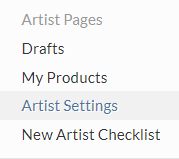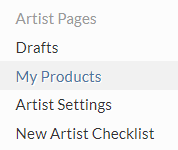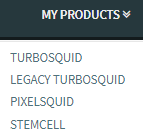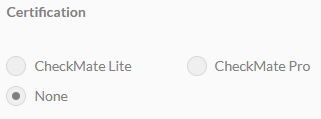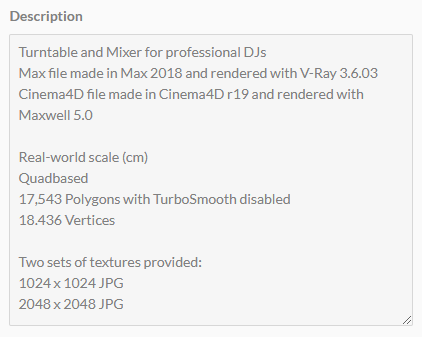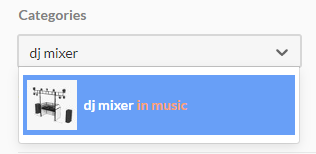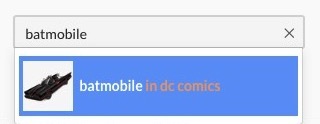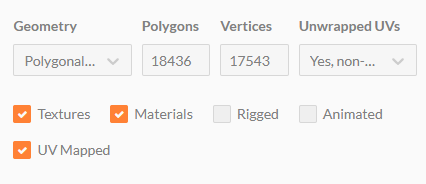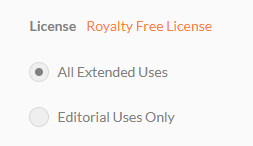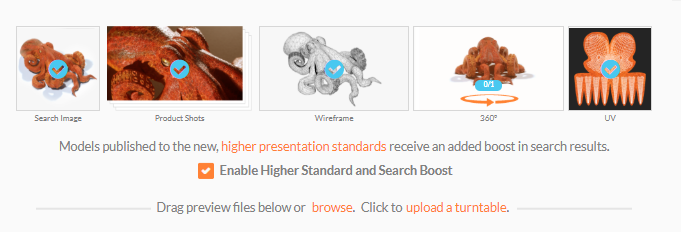Table of Contents
Before you will be allowed to publish a model, you must first complete your payment information. To access your payment information, go to the Account pulldown and choose Artist Account. For assistance with completing your payment information, please visit our How to Get Paid Knowledge Base article.
Accessing Publisher
Once you have completed your payment information, go to Account in the site header and select My Products.
You can also access publisher from your Squid.io dashboard by going to My Products and choosing TurboSquid.
You have two options for publishing your models: Beta Publisher, which is our newest publishing and Legacy Publisher, which is our old publishing system.
Once you are in My Products, you have the option to publish your models with either Beta Publisher or Legacy Publisher. There is a toggle that allows you to choose the publisher that you wish to use.
Once you have chosen your publisher, you can start uploading a product by clicking on Create New Product.
On the 3D MODEL FILES tab, you can either drag and drop your model archives or click on Browse to access the files on your computer.
For each file format that you have provided, you will be prompted to provide the version of both the application you used and the Renderer you used when you created the file. If you do not know the version of the Renderer, it is o.k. to leave this blank.
Additionally, it is important for customers to know which program you used to create the original file–this is called your native file format. In publisher, you should click on select native file format to specify which file is the original format.
If you find that you have selected the wrong native file, you can remove the designation by clicking on the x in the blue NATIVE box.
When titling your product, be sure to pick a name that describes the model you are publishing. The Product Title helps your model show up in relevant Google searches. Since a large percentage of TurboSquid’s traffic comes from Google searches, the impact of a good product name can be significant. For more information about how to name your products, please see our Product Names Knowledge Base article.
Publishing artists set their own prices on their items on TurboSquid, but you should make sure you are pricing your models to achieve maximum sales and royalties. We have provided Product Pricing Guidelines that are designed to help you choose appropriate prices for your models.
If you are a SquidGuild member, you have the added benefit of submitting your models for CheckMate Certification. CheckMate is the industry standard for 3D modeling and has been developed by TurboSquid after years of industry research. The CheckMate standard includes best-practices that are used internally by major visual effects companies, game developers, advertising agencies and designers.
In publisher, the Certification option defaults to None. If you wish to submit your model for CheckMate Pro or CheckMate Lite, you would simply choose which option you would like and when you publish, your model will automatically be submitted for certification. For more information about the CheckMate submission process, please check out or articles about CheckMate and how to submit your models for certification.
Description
To make the most sales for your 3D model, your product Description needs to include vital information that is presented in a professional manner. Write your Description with the customer’s viewpoint in mind. Think about what the customer needs to know in order to make a decision about purchasing your 3D model. If you need help, please review our article about preparing the best Product Descriptions possible.
Tags
Tags are keywords that will help customers find your models in the Search. You should choose keywords that correctly describe the model you are selling. For the best search results, be sure that you only use keywords that apply to the model. For example, if you are selling a kitchen sink, don’t use words like dishwasher. If customers are searching for a dishwasher, they are not going to buy your sink model if it shows up in the dishwasher search—they’re not looking for a sink.
Assigning categories and, where necessary, brands to your products allows customers to more easily find your models.
Categories
When choosing an object Category, you will want to choose the category that best fits the model or collection you are uploading. If there’s a more specific category available, you may see a ‘View x more specific categories’ link. This will allow you to choose an even more specific object category for your model. All products must have at least one object category assigned.
As with Tags, choosing an accurate category will help customers find your model which will generate more sales. You should use no more than 3 categories for your model. If you are uploading a collection or scene, you don’t need to provide a category for each object–use general categories that describe what it is you’re selling.
Brands
The 3D Model License for Customers section allows you to add categories that help customers identify intellectual property belonging to other companies represented in your model. If your model contains any brands or products, you should choose the ‘Yes’ option in this section. Choosing ‘Yes’ will assign the proper license and reveal a new search field in which you can search for the specific company or product that is depicted in your model. As with the Categories section, you should choose the most specific brand or model that is available. Selecting ‘No’ in this section indicates that there is no intellectual property represented in your model that you do not own the rights to.
If you can’t find the brand or company that you are looking for, click the link to Report a missing brand. When you publish your model, a message will be sent to our team, and we can add the necessary information to our database.
For more information on model licensing, please refer to The TurboSquid 3D Model License.
Product Specifications
Geometry
It is incredibly important for you to choose the exact Geometry-type that you are providing. TurboSquid customers have long expected to know the underlying constructions of models before they buy them. Understanding if the model will fit within their own pipeline from a topological perspective is incredibly important when making a purchasing decision.
Polygons and Vertices Counts
Customers often have polygon and vertices “budgets” or limits for their work, particularly when using assets for games or real-time mobile applications. When you provide your polygon and vertices counts in this section of the publisher, it is important for you to provide an accurate count. Otherwise, it is possible that a customer will buy your model with one set of expectations, and ultimately find out that they can’t use a model without having to modify it.
Product License
If your Stock Media Product depicts certain subject matter, you are required to affix notice of Editorial Use limitations for customers. Please see this page for an explanation including a link to our FAQ-for-customers about Editorial limitations.
When publishing a model on TurboSquid, you need to create the following Preview Images: One Search Image, Five Product Shots, One Wireframe, and One 360° Turntable. You can substitute a Marmoset mview file for your Turntable, but you must upload .mview files on the Texture & Other Files tab. Our supported image formats are jpg, png, and gif. Please see our Product Imagery Checklist for more information about our imagery requirements.
If you use Beta Publisher and meet all of the higher presentation standards, you will receive a bonus search boost for the model. You will need to click on Enable Higher Standard and Search Boost in order to qualify for this. Please note that this feature is only available in Beta Publisher.
Customers use Search Images to quickly identify models that may work for their projects. To give customers the best possible search experience possible, you must follow TurboSquid’s Search Image requirements. The Search Image must have a square aspect ratio at a resolution of at least 1200 × 1200. For most models the background color must be 247 white (RGB 247, 247, 247). There are some exceptions to the 247 white requirement, such as interiors. You can find more information about Search Image requirements in our Search Image article.
When you upload your product images, TurboSquid’s publisher will automatically detect which image has a square aspect ratio and will then designate this as your Search Image.
Product Shots showcase the beauty of your models and should show various angles, unique aspects, and important details of your models. You are required to submit at least five (5) Product Shots that are rendered at a minimum resolution of 1920 x 1080– you are certainly free to provide larger images if you wish. There is no aspect ratio requirement for Product Shots, and you are free to provide more than the five required images.
Wireframe Images show the construction of the model. You are required to provide at least one wireframe that is rendered at a minimum resolution of 1920 x 1080. For meshes that are subdividable, we encourage you to create additional images that show the subdivision levels. If you need help with creating wireframes, check out our Creating Wireframes article.
A turntable is a sequence of renderings that plays in the Preview Window. Turntables give customers a complete view of your 3D model so they can make intelligent purchasing decisions.
You are required to provide one Turntable made up of 12 images (up to a max of 72) and render at a minimum 1920 x 1080 resolution. If you need help with creating Turntables, please see our step-by-step walkthrough.
To upload your turntable, click on upload a turntable and then select your files.
Once you have completed the upload, you will see the 360° turntable in your imagery files.
While UV images are only required for models that will be certified for CheckMate Pro, they can be extremely helpful for customers if your model has been unwrapped. For more information about UV images, please visit our UV Layout Images article.
Once you upload your images, you will need to designate what type of imagery each thumbnail represents: Image (Product Shots), Wireframe, and UV. All non-turntables images will default to the Image type. In order to meet the presentation standards, you will need to assign an appropriate designation to your models.
You are not required to upload files to the Textures & Other Files section, but it is available for you to use if you wish to provide customers with promotional downloads, customer bonus downloads, texture archives, or Marmoset mview files.
Promotional Download
If there are preview files that you would like to provide to your customers, such as a file that shows how your model is animated, you would upload the files here. Publishing here will push the files to the product page where potential customers can download and review.
Please note: If there are files that you only want to make available to purchasers, do NOT choose Promotional Download. Files uploaded under Promotional Download will be available to everyone who browses the site.
Customer Only Download
If you would like to provide bonus files for your customers, you can upload those here. Publishing here will push the files to their product download section.
Textures
While you are free to archive your texture files with your 3d model files, textures can sometimes increase the size of the archives significantly. Uploading your texture files separately in the Textures & Other Files section can help address those issues.
Marmoset Toolbag allows artists to showcase their work in a real-time environment so that others can review their geometry and animation and help with look-dev and lighting. It is incredibly simple to use, and it also gives artists a solid understanding of where possible issues lie within their modeling and texturing workflows. If you would prefer to use a Marmoset file instead of a Turntable, you are allowed to make that substitution.
To remove a product from TurboSquid:
- Go to My Products
- Click on the checkbox next to the product you wish to remove
- Under the Actions pulldown, click on Remove
TurboSquid artists can still access and publish using the Legacy Publisher. Since the publishing standards are not as strict as those with Beta Publisher, you will not receive a search boost if you publish using Legacy Publisher.
How do I access Legacy Publisher?
To access Legacy Publisher, toggle Beta Publisher off.

